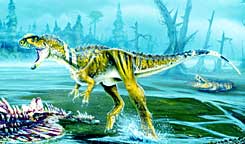20 million years after what was believed until now, according to the remains of the dinosaur Rogops primus found in Niger

Rugops primus. Relatives in South America.
A collection of dinosaur remains discovered in Niger in Africa may revolutionize the understanding of the process by which the continents were formed. So claims a team of paleontologists led by Prof. Paul Serrano from the University of Chicago in the USA.
Serrano last week presented some of the dinosaur remains he discovered in the excavations he carried out in Niger four years ago. The most significant find discovered in the excavations is the skull of "Rugops Primus" (Rugops Primus, "the first wrinkled face" in Latin), a dinosaur with a special appearance. According to Serrano, the skull is decisive evidence for his theory, according to which Africa and South America separated at a later time than previously thought - 100 million years ago, and not 120 million years ago (or that the two were connected by "land bridges" after they separated).
Rogops, who lived about 95 million years ago and stood 9 meters tall, had a rounded nose, small teeth and a body covered in hard armor. According to Serrano, the structure of the dinosaur shows that it was not a great warrior, and most likely it used to find its food by gathering. From two rows of seven holes, which were found along the nose of the Rogops, emerged a crest or horns. "This is a great intermediate species that belongs to a group that later evolved into the first horned carnivores," Serrano said. Four years ago Serrano's team explored an area in the Sahara desert that was no bigger than a basketball court. The team uncovered dinosaur remains from the late Cretaceous period; The amount of remains was greater than all the remains of dinosaurs previously discovered in the entire continent of Africa.
According to Serrano, the most interesting thing about Rogops is his lineage. Serrano discovered that the dinosaur had "family ties" in South America: it belonged to a group of dinosaurs called abelisaurids, whose remains have so far been found in South America, Madagascar and India, but not in Africa.
The new finding led the team of scientists to conclude that Africa broke away from the ancient supercontinent Gondwana at a later time than previously estimated. "If movement between the two continents had not been possible, it would not have been possible to find relatives of the Abelizaurids in Africa during this period," Serrano is convinced.
According to Jeffrey Wilson of the University of Michigan, who co-authored the study with Serrano, "until the continents finally broke apart, dinosaurs like rugops and other animals used land bridges to colonize neighboring continents."
The find of Serrano, the most famous "dinosaur hunter" today, is the latest in a long series of discoveries. In the last ten years Serrano has found or helped to identify many types of dinosaurs.
